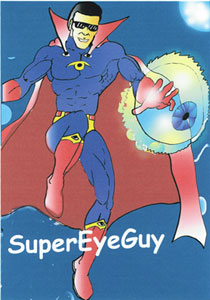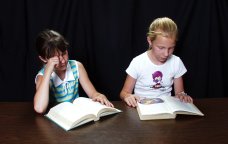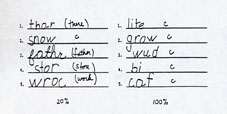
Paediatric Vision Therapy

The Paediatric Vision Clinic at Vision Centre was established in response to a need for specialty eye care for children specializes in the evaluation, diagnosis, treatment, remediation, and enhancement of the visual systems of children. Our services include
• Eye exams for kids. We are specially equipped to perform eye exams without making them scary or intimidating. We use a calm and friendly approach and we make the tests fun. From special eye charts with pictures (instead of letters) to superfast auto refractor machines that take the guess work out of vision tests, we cater to kids. We even have a flat screen TV in the exam room that plays favourite DVDs while we do the work.
• Explanations for parents. We take the time to talk to you about your child’s visual development, explain vision problems and give you treatment options.
The Paediatric Vision Clinic at Vision Centre was established in response to a need for specialty eye care for children specializes in the evaluation, diagnosis, treatment, remediation, and enhancement of the visual systems of children. Our services include
• Eye exams for kids. We are specially equipped to perform eye exams without making them scary or intimidating. We use a calm and friendly approach and we make the tests fun. From special eye charts with pictures (instead of letters) to superfast auto refractor machines that take the guess work out of vision tests, we cater to kids. We even have a flat screen TV in the exam room that plays favourite DVDs while we do the work.
• Explanations for parents. We take the time to talk to you about your child’s visual development, explain vision problems and give you treatment options.
• An interdisciplinary approach. If your child’s vision problem is affecting school performance or behaviour issues, we will work in cooperation with teachers, school nurses, psychologists, paediatricians and other professionals as directed by the parents. We provide a thorough written report of our findings.
• Special testing. When indicated based on the eye exam or other symptoms, will run specialized diagnostic tests as part of a binocular vision evaluation or developmental vision evaluation.
• Vision therapy. The Paediatric Vision Clinic has a special department for vision therapy (VT). Through a series of VT sessions in our office under the direction of and with the use of special optical and electronic devices, the patient is trained to use his or her visual system properly. Home VT exercises are also recommended. See more below.
• Eyeglasses for the younger set. We have lots of frames that look cool and fit well so kids actually love their glasses! We use durable products and safe polycarbonate lenses plus we have a great warranty program -- but kids will be kids and we are always here to repair glasses when needed.
• Contacts are OK for kids. Contact lenses have changed and they are safer and more convenient than ever, making them a great option for younger children. Disposable contacts take the worry out of losing lenses. Personal appearance and self-esteem are important factors in a child’s development and many kids are thrilled with the idea of not wearing glasses. Contacts are a great option for sports and other activities. An easy in-office free trial can tell us if a child is ready.
The Optometric Centre of Brisbane specializes in complete diagnostic and therapeutic care for children and adults with vision problems, ranging from eye tracking, eye teaming and eye focusing disorders (Visual Efficiency Evaluation), strabismus and amblyopia (Strabismus/Amblyopia Evaluation) to learning-related vision problems (Visual Information Processing Evaluation). The Centre also features specialty care of acquired brain injury related vision problems, computer related vision problems, and sports vision.
The Vision Therapy Service is recognized as a regional referral Centre for children and adults with vision problems. We receive referrals from a broad source, including optometrists, physicians, psychologists, educators, and rehabilitation professionals.
What is Vision Therapy?
Vision therapy is a sequence of therapy procedures that are individually prescribed and monitored by the doctor to develop efficient visual skills and visual processing. Vision therapy is prescribed following a comprehensive evaluation of the visual system (visual efficiency evaluation, strabismus and amblyopia evaluation, visual information processing evaluation) that has indicated that a program of vision therapy is an appropriate treatment option. The vision therapy program is based on the results of standardized tests, the patient’s specific signs and symptoms and the needs of the patient. The use of lenses, prisms, filters, occluders, specialized instruments and computer programs is an integral part of vision therapy.
Typically, vision therapy is administered as a combination of in-office visits combined with prescribed, daily, home-vision therapy procedures. The in-office therapy is designed to make the patient aware of his or her visual deficiencies under controlled conditions. Then by a feedback process the patient is taught strategies to improve visual performance. Home therapy is directed at practicing the newly learned visual skills until the initial conscious effort becomes automatic.
Vision Efficiency Evaluation (VEE)
 The Visual Efficiency Evaluation (VEE) is a specialized test battery that carefully examines the visual system. Many patients have good eyesight, 20/20 or better, but have symptoms due to poor visual efficiency. Visual efficiency refers to how effectively and comfortably the visual system gathers visually presented information and is comprised of three general areas: Eye tracking, eye focusing and eye teaming. When a person has deficiencies in any of these areas, symptoms or poor performance may result.
The Visual Efficiency Evaluation (VEE) is a specialized test battery that carefully examines the visual system. Many patients have good eyesight, 20/20 or better, but have symptoms due to poor visual efficiency. Visual efficiency refers to how effectively and comfortably the visual system gathers visually presented information and is comprised of three general areas: Eye tracking, eye focusing and eye teaming. When a person has deficiencies in any of these areas, symptoms or poor performance may result.
Deficiencies in eye tracking may cause a person to rely on a place marker, lose their place, or inadvertently re-read text during reading tasks. Inefficient eye focusing can cause blurred vision, eyestrain, and reduced reading comprehension. A particular type of eye focusing deficit called accommodative infacility will cause a person difficulty when shifting their focus between near and far distances (e.g., copying from the chalkboard). Persons with poor eye teaming often experience eyestrain, fatigue, headaches, double vision, or complain that text appears to "float or move around" on the page.
Inefficient visual skills can affect children and adults in academic, sports, or occupation performance. The Visual Efficiency Evaluation is a valuable tool to determine if visual inefficiency is preventing a patient from reaching their full potential.
Paediatric Vision Services
The Paediatric Vision Service provides vision examinations starting in early infancy and continuing through the school years. Although young children may not be able to read an eye chart, specialized procedures have been developed that allow us to measure the clarity of sight of children at almost any age. We use the latest technology for evaluating the vision of young children. ”The Optometric Association guidelines recommend that all children have a complete vision and eye health examination at the age of 6 months, 3 years, upon entering kindergarten, and routine vision care (every 2 years) thereafter throughout their school years." Many vision problems can be corrected more easily with early diagnosis and treatment. Reports have estimated that up to 25% of students in grades K–6 have vision-related problems, which may contribute to poor school performance. The visual system matures rapidly during the first few years and it is important to identify any problems that may interfere with normal vision development.
Eye Examinations for Infants, Toddlers and School-aged Children
A comprehensive eye examination will assess visual acuity, refractive status, ocular health, eye tracking, eye focusing, and eye teaming. Visual acuity measures how clearly a child sees objects. Refractive status measures for near sightedness (myopia), farsightedness (hyperopia), and astigmatism. The child is evaluated for any eye health problems, including active pathology or congenital anomalies.
Early detection of vision problems and management is recommended to prevent vision loss or eye disease and to provide appropriate vision development. To learn more about how the examination process differs for infant, preschool, and school-aged children visit the links. As part of the visual examination we also assess vision development. Young children use vision to explore the world by identifying and directing movement. If a problem in vision is preventing adequate development of perception and eye-hand coordination skills then early intervention is vital.
Visual Information Processing Evaluation (VIPE)
 Visual processing refers to a group of skills used for interpreting and understanding visual information. These skills are important for many tasks that children perform in the classroom. For example, a child might need to look at something on the board and then write down the information or solve the problem. In this example the child needs to remember what they saw (visual memory) and write the information accurately (visual motor integration). Children who have problems in visual processing typically have one or more of the following symptoms: reversal errors, difficulty remembering what is read, poor understanding of right and left directions, and poor handwriting.
Visual processing refers to a group of skills used for interpreting and understanding visual information. These skills are important for many tasks that children perform in the classroom. For example, a child might need to look at something on the board and then write down the information or solve the problem. In this example the child needs to remember what they saw (visual memory) and write the information accurately (visual motor integration). Children who have problems in visual processing typically have one or more of the following symptoms: reversal errors, difficulty remembering what is read, poor understanding of right and left directions, and poor handwriting.
If a visual processing problem is suspected, an evaluation using standardized tests may be recommended. We typically evaluate visual spatial, visual analysis, and visual motor skills. Following testing, an individualized treatment plan is designed that targets the weak areas. Vision therapy is expected to improve the deficient visual processing skills, which should in turn help remove barriers that affect classroom performance.
What is a Learning-Related Visual Problem?
A learning-related visual problem is identified when vision problems keep a child from performing optimally in school. Children found to have learning related vision problems may have a number of symptoms which may include reversal errors, poor written work and/or difficulty recalling and recognizing letters and words.
Individuals having difficulty achieving in school should be evaluated to identify any vision problems, which may contribute to their difficulty. Visual efficiency or visual information processing deficiencies may result in inattentiveness and an inability to accurately acquire information important in the learning situation.
The optometric evaluation of these individuals is not intended to diagnose and treat learning problems, but rather visual efficiency and/or visual information processing difficulties, which may be one of many factors contributing to poor achievement. Also, awareness of vision problems will assist the classroom teacher in planning or modifying educational programs to best serve the student.
Dyslexia: What is it?
Dyslexia means poor word recognition. Although vision is involved, dyslexia is mainly a language processing problem. This learning disability affects reading and writing, particularly spelling. Dyslexia results in specific patterns of reading dysfunction, as opposed to general reading dysfunction caused by such broad factors as poor visual or auditory skills, lack of education, attention problems, and reduced intellectual capacity.
 When general factors affecting reading are accounted for, specific testing for dyslexia is done. Dyslexia affects all ages. Both children (as young as kindergartners) and adult patients can be screened for dyslexia at the Vision Therapy Service of the Optometric Centre of Brisbane.
When general factors affecting reading are accounted for, specific testing for dyslexia is done. Dyslexia affects all ages. Both children (as young as kindergartners) and adult patients can be screened for dyslexia at the Vision Therapy Service of the Optometric Centre of Brisbane.
Faculty optometrists and student interns at OCLA screen for three basic types of dyslexia: 1. Dysnemkinesia ("motoric"); 2. Dysphonesia ("auditory"); and, 3. Dyseidesia ("visual"). The dysnemkinetic type is associated with letter reversals when writing linguistic symbols; for example, doy for boy. Letter reversals, as well as other right/left problems, can often be treated successfully with optometric vision therapy. The two other types of dyslexia require special educational therapy. The dysphonetic type of dyslexia results in poor word attack skills (phonetic decoding) and transposition of letters when writing, for example solw for slow. The dyseidetic type of dyslexia results in poor sight-word recognition and inaccurate spelling, although phonetically correct, for example, bisnis for business.
Faculty consultants at Vision Therapy Service are part of a multidisciplinary team of professionals that consists of physicians, psychologists, educators, and other professionals who are concerned with learning disabilities. When the type and severity of dyslexia are determined, appropriate referrals for educational therapy can be made, which may then be carried out at the child’s school or other locations. Educational therapy for adults may be provided by local organizations such as Literacy Volunteers .
Appropriate referrals can also be made when other evaluations or therapies, such as for attention deficit disorders, are indicated. Vision Therapy may be recommended if contributing problems such as poor eye teaming, tracking, focusing, and visual information processing are found in combination with dyslexia. The goal of vision therapy is to decrease visual symptoms and improve the child’s “visual” readiness for the classroom.